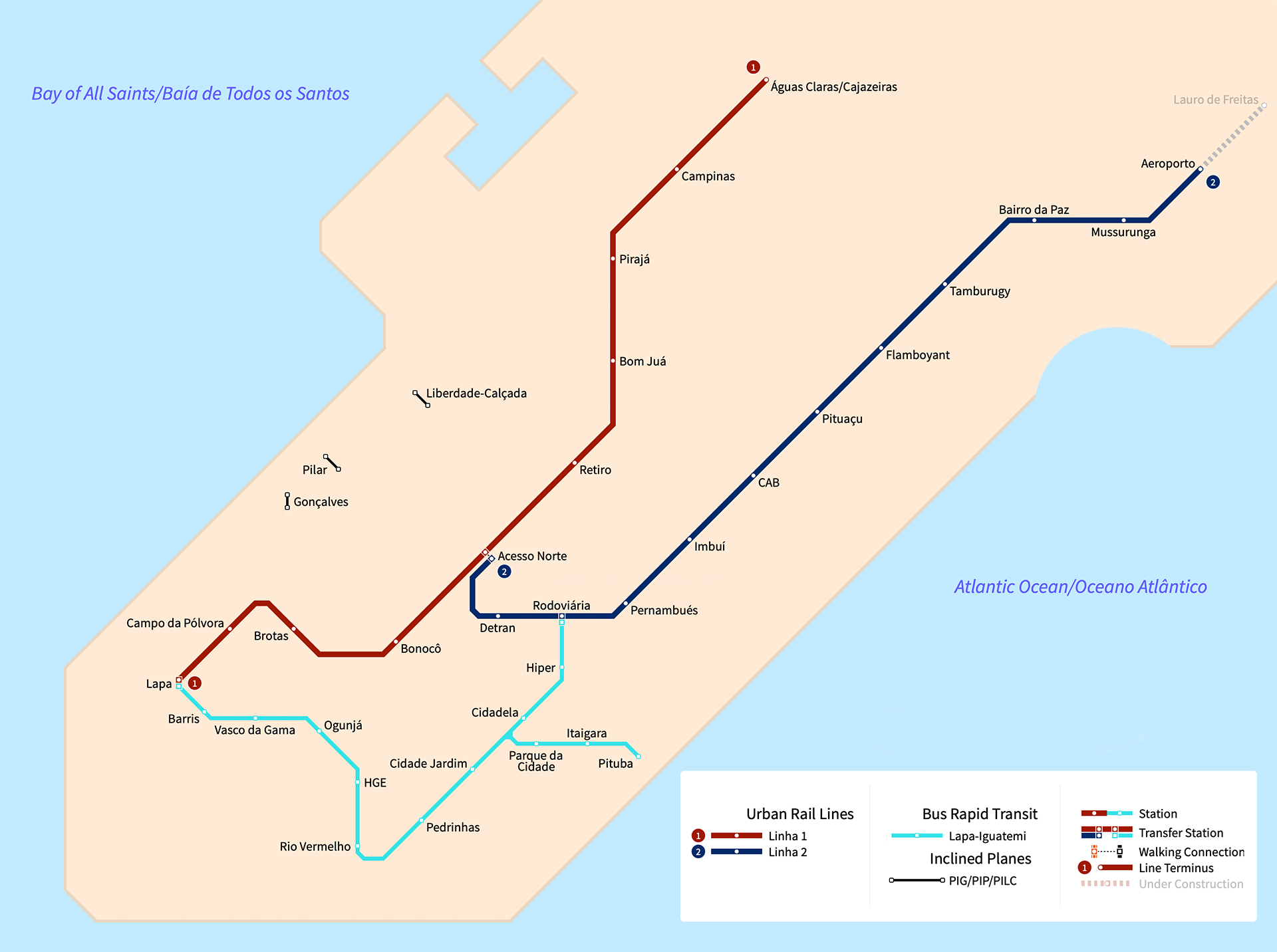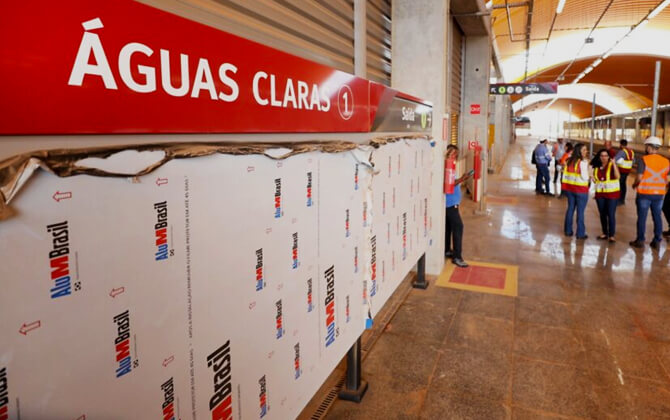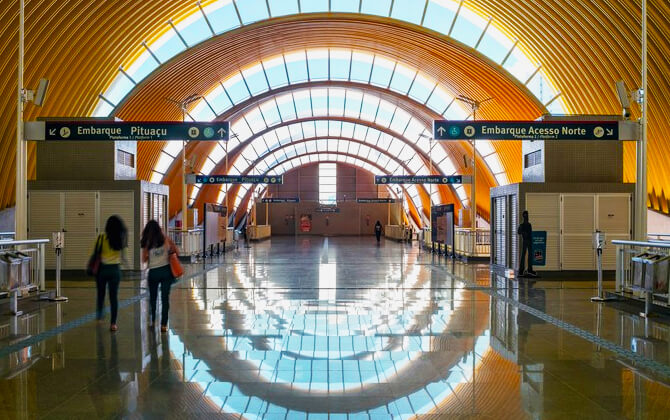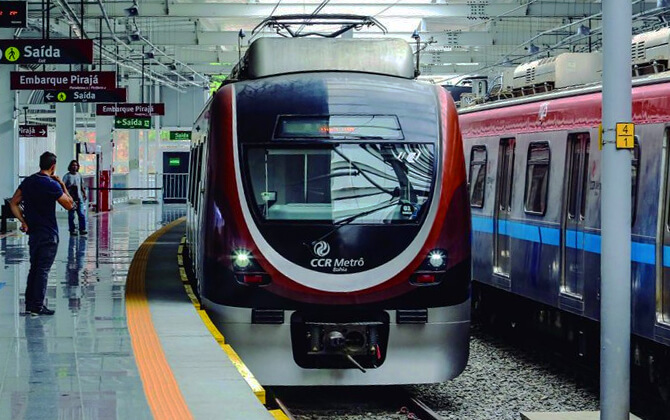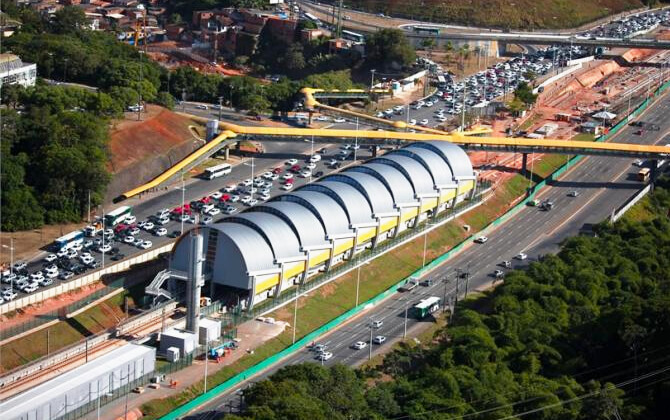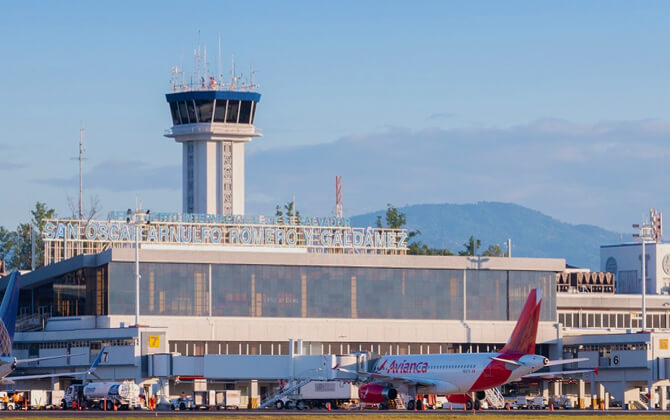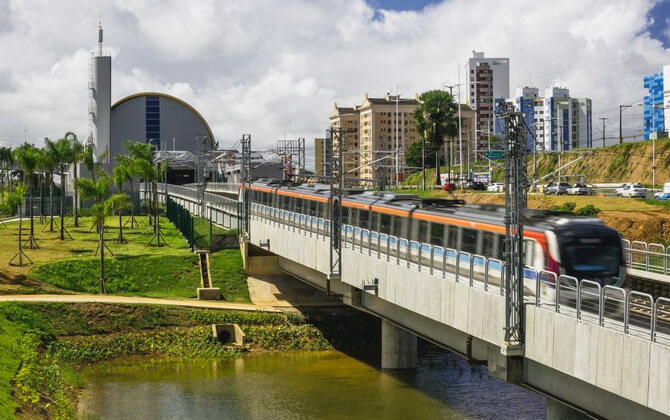The Salvador Metro (Metrô de Salvador) is a transportation network in the city of Bahia, Brazil. Today in 2026, the Salvador Metro system consists of 2 lines. The total length of 22 inspections is 38 km (about 23.6 miles). The metro connects the city center with the suburbs and the Salvador International Airport. About 370,000 passengers are served daily. There were many problems and delays during the creation phase. Initially planned to open in the late 1990s, but construction did not begin until 2000. Due to financial problems, construction was delayed for many years. In the end, the first line did not open until 2014, the second in 2016. In 2018, line 2 was extended to the airport, and in 2023, line 1. was extended to Águas Claras/Cajazeiras. This completed the original metro plan. The construction lasted 23 years.
Salvador Metro Map
Below is a detailed Salvador Metro map. Click on the map to enlarge it or download the Salvador Metro map in PDF format.
Salvador and Lauro de Freitas Metro System
Salvador Metro Lines, Routes, and Stations
The Salvador Metro has two lines: Line 1 (Red) and Line 2 (Blue). They intersect at Acesso Norte for easy transfers.
Line 1 (Lapa – Águas Claras)
This 16.4 km line links downtown Salvador with western suburbs. It has 10 stations and a 24‑minute end‑to‑end trip. Most of the route is elevated or at grade, with a short tunnel between Lapa and Campo da Pólvora.
Stations List and Photos – Line 1
- Lapa: Underground station at Terminal da Lapa. (Opened 2014)
- Campo da Pólvora: Underground stop near Fonte Nova Arena. (Opened 2014)
- Brotas: Elevated station on Bonocô Avenue. (Opened 2014)
- Bonocô: Elevated stop with modern facilities. (Opened 2015)
- Acesso Norte: Ground‑level transfer to Line 2. (Opened 2014)
- Retiro: At‑grade station with BR‑324 bus connections. (Opened 2014)
- Bom Juá: Elevated station serving the local community. (Opened 2015)
- Pirajá: Transfer point with the Pirajá Bus Terminal. (Opened 2015)
- Campinas: Elevated stop in Campinas de Pirajá. (Opened 2023)
- Águas Claras/Cajazeiras: Southern terminus with bus links. (Opened 2023)
Line 2 (Acesso Norte – Aeroporto)
This 21.6 km line runs from Acesso Norte to the airport area. It has 12 stations and takes about 25–27 minutes. All stops are either elevated or at grade.
Stations List and Photos – Line 2
- Acesso Norte: Transfer to Line 1 and mall access. (Opened 2014/2016)
- Detran: Elevated station near the traffic department. (Opened 2016)
- Rodoviária: Connected to the main bus terminal. (Opened 2016)
- Pernambués: Elevated stop in a busy district. (Opened 2017)
- Imbuí: At‑grade station near UFBA. (Opened 2017)
- CAB: Station at the government center. (Opened 2017)
- Pituaçu: Elevated stop with park‑and‑ride. (Opened 2017)
- Flamboyant: Elevated station along Avenida Paralela. (Opened 2017)
- Tamburugy: At‑grade stop near the river. (Opened 2017)
- Bairro da Paz: At‑grade station in a dense neighborhood. (Opened 2017)
- Mussurunga: Elevated hub for eastern suburbs. (Opened 2017)
- Aeroporto: Airport station with shuttle link. (Opened 2018)
Future Expansions
Line 1
As of 2026, there are no plans to extend Line 1 past Águas Claras. Any work will focus on improving tram and bus feeders.
Line 2
A 3 km extension into Lauro de Freitas is proposed. It may end near Shopping Estrada do Coco. No dates are set.
New Routes
No new metro lines (such as Line 3) are being built. Salvador is adding tram and BRT links at Águas Claras and Bairro da Paz. This is faster and cheaper than new metro tracks.
Salvador Metro Operating Hours and Schedule
Metro Timetable and Frequency
The metro runs daily from 5:00 am to midnight. On weekdays, trains come every 5–8 minutes—these Salvador metro timings reflect the official timetable provided by CCR Metrô Bahia. During rush hours, they run every 5 minutes; midday and early evening trains run every 8 minutes.
On Saturdays, trains arrive every 7–10 minutes. On Sundays and holidays, every 10 minutes. The schedule is reliable, and special events may extend hours.
Opening and Closing Times
All stations open at 5:00 am. The first trains depart then, and stations close at midnight. Last trains leave end stations at 11:30 pm—make sure you board by 11:30 pm at terminus stations or by 11:45 pm mid‑route. After midnight, you’ll need to use night buses or taxis.
First and Last Train Timings Today
First trains depart at 5:00 am from Lapa and Águas Claras on Line 1. On Line 2, they leave Acesso Norte and Aeroporto at 5:00 am. Last departures are at 11:30 pm from end stations, with all services finishing by midnight. Check exact times on the CCR Metrô Bahia app or station displays to confirm your trip.
Salvador Metro Ticket Prices and Fares
Fare Calculator
A single ride costs R$ 4.10 (about US$ 0.80). A metro+bus trip within 2 hours costs R$ 5.60 with a transit card. Without a card, you pay R$ 4.10 each time. This simple Salvador metro fare structure makes budgeting easy.
- Metro only: R$ 4.10 per ride.
- Metro + bus: R$ 5.60 with integration card.
Reloadable cards apply integration automatically.
Ticket Options and Pricing
Tickets include single‑ride cards, integration cards, SalvadorCARD, Metropasse, and special fare cards for students, seniors, and disabled passengers. Here’s a quick overview of how the Salvador metro ticket price varies by card type:
- Single Ride Card: One trip for R$ 4.10. No bus transfer.
- Integration Card: Metro + bus for R$ 5.60 within 2 hours.
- SalvadorCARD: Reloadable for metro and buses.
- Metropasse: For employees. Not sold at stations.
- Special Fare Cards: Discounts for students, seniors, and disabled.
There is no day pass. Most riders use single or integration cards, keeping the cost and process straightforward.
Salvador Metro Day Pass – Is It Worth It?
There is no unlimited day pass. Four rides cost R$ 16.40 (~US$ 3.25). Given current fare levels, pay‑as‑you‑go with a reloadable card is usually the most economical choice.
Parking Facilities
Parking Charges at Stations
Most stations have no parking. Only Pituaçu Station offers a private lot by Natural Park. It costs R$2.00 per hour, billed every 30 minutes. Sometimes events bring special rates or free days. There are about 300 spots.
Other stations offer drop‑off zones or street parking. These spots can be scarce or unsafe. Many riders use buses, taxis, motorcycles or bikes. Acesso Norte and Bom Juá have bike racks.
Station Parking Availability and Fees
Pituaçu Station is the only one with official parking. It costs about R$2 per hour, up to R$16–20 daily. Ask Natural Park about monthly passes.
Other stations only have short‑term drop‑off or informal parking. Mussurunga and Acesso Norte have loops. Rodoviária is mainly for buses. Disabled spots need a permit.
Use feeder buses, ride‑share or bikes to reach stations instead of driving.
Connection from Salvador Metro to Salvador International Airport
How to Get from Salvador Airport to Barra and City Center
A free shuttle bus runs every 10 minutes from all airport terminals to Aeroporto station. Then take Line 2 to Acesso Norte and switch to Line 1 for downtown.
For Pelourinho, get off at Campo da Pólvora and walk. To reach Barra, stay on to Lapa and take a short bus or taxi (3 km).
The trip takes about 70 minutes and costs R$4.10. A taxi costs around R$140. The metro‑shuttle is cheaper but may be hard with big luggage or late at night.
Metro Route to Salvador Airport – Stations and Transfers
- At Lapa or Campo da Pólvora, take Line 1 toward Águas Claras.
- Change at Acesso Norte to Line 2 toward Aeroporto.
- Ride about 25 minutes to Aeroporto station. Then board the free shuttle to terminals.
Total travel is about one hour. Metro fare is R$4.10, or R$5.60 with a bus transfer.
Last trains leave end stations at 11:30 pm. Plan ahead for late flights.
Salvador BRT System – Integration with Metro
BRT Lapa-Iguatemi Route and Connections
Since 2024, the Lapa–Iguatemi BRT links Lapa to Rodoviária/Iguatemi. This bus line cuts travel time on main avenues.
You can transfer inside Rodoviária station between BRT and metro. Use SalvadorCARD or Metropasse for a free transfer within 2 hours.
The BRT skips traffic on dedicated lanes. Key stops include Rio Vermelho, Cidade Jardim, and Pituba. It also serves the hub near Shopping da Bahia.
To reach Imbuí, change at Rodoviária. To go to the airport from Parque da Cidade, use BRT then metro.
Salvador’s Historic Funicular Railways (Plano Inclinado)
Salvador also has old funiculars called “planos inclinados.” They link the Lower City to the Upper City along steep cliffs. These rails run for over 100 years. They are useful and offer great views of the bay.
Plano Inclinado Gonçalves
Links Comércio to Pelourinho near Praça da Sé. Opened in 1874, electrified in 1910, updated in 2014. Carries about 1,200 riders daily. Fare is R$0.15. Runs weekdays from 8 am to 6 pm. Stops near Mercado Modelo and the Naval Museum. Offers scenic bay views. Locals often bring bikes.
Plano Inclinado Pilar
Links Santo Antônio Além do Carmo to Comércio. Opened in 1897, rebuilt in 2006 and 2015. It is free. Runs weekdays from 7 am to 5 pm. About 190 daily riders. Lower station is near warehouses and galleries. Upper station is close to cafes and old buildings.
Plano Inclinado Liberdade-Calçada
Opened in the early 1980s, it connects Liberdade and Calçada. Restored in 2014. About 4,000 daily riders. It is free. Runs weekdays from 6 am to 6 pm and Saturdays until 1 pm. Shows everyday life in Liberdade’s Afro‑Brazilian community.
These funiculars mix history and function. They serve tourists and locals. Each offers a special city view.
Salvador Tramway System
History and Current Status of Trams in Salvador
Salvador had electric trams from the late 1800s. They stopped in the 1960s and were replaced by buses. Later, only funiculars ran on rails.
In 2021, a monorail project began but was canceled in 2022. Suburbs lost rail service again.
Future Tramway Projects and Integration
In early 2024, the state announced a 36 km tram network with three lines:
- Line 1 (Calçada–Ilha de São João): 16.6 km, 17 stops along the bay.
- Line 2 (Paripe–Águas Claras): 9.2 km, links Paripe to Águas Claras metro.
- Line 3 (Águas Claras–Piatã): Crosses west–east, joins metro at Bairro da Paz.
These trams will use shared tickets and easy transfers with the metro. Building starts in late 2024 or early 2026. Sections may open by 2026–2027. They will boost affordable transit for suburbs.
Tips for Safe Travel
Is Salvador Metro Safe? Essential Safety Tips
The metro is safe. Stations have CCTV, lights, and staff. Crime is rare. Still, watch your bags and avoid showing valuables. Stay aware, especially at night.
Use emergency intercoms if needed. Late at night, pick cars with people. Listen to staff patrols.
Some stations are quiet after dark. For safety, use buses, taxis, or rideshares. Overall, the metro is clean, reliable, and secure.
How to Use Salvador Metro – Step-by-Step Guide
To use the metro:
- Check the map or app for your route.
- Buy a ticket (R$4.10) or SalvadorCard.
- Tap in at the turnstile.
- Follow signs to the right platform.
- Wait behind the line and board when doors open.
- For transfers, follow signs inside the station. No extra fare.
- Exit through marked gates—no tap out needed.
- For buses or taxis, find stops near the station.
This metro is easy, safe, and cheap. It helps you beat city traffic.
